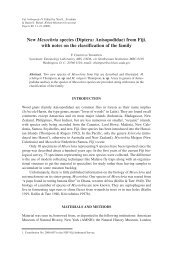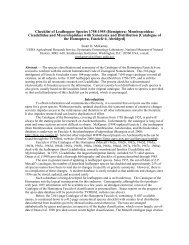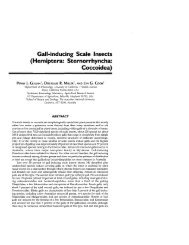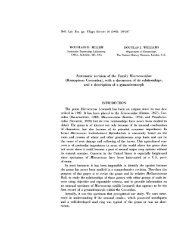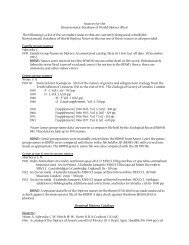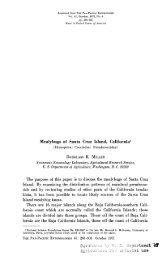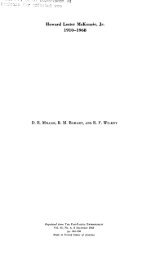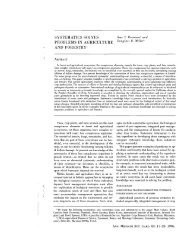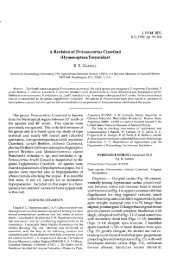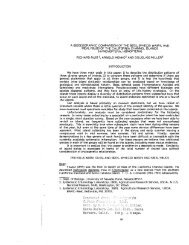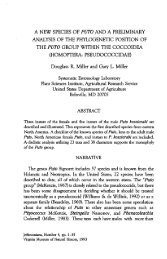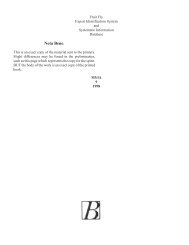A new leaf-mining Allograpta from Costa Rica - Systematic ...
A new leaf-mining Allograpta from Costa Rica - Systematic ...
A new leaf-mining Allograpta from Costa Rica - Systematic ...
You also want an ePaper? Increase the reach of your titles
YUMPU automatically turns print PDFs into web optimized ePapers that Google loves.
Studia dipterologica 9 (2002) Heft 2: 421–436ig. 1: <strong>Allograpta</strong> centropogonis NISHIDA spec. nov., imago, dorsal view (drawing by Leonardo DONZO).Results<strong>Allograpta</strong> centropogonis NISHIDA spec. nov.[igs. 1–3a–c (imago), 4–9 (larval morphology), 10–35 (biology)]Imagines (male and female) (ig. 1).Head (ig. 2): ace projecting anteriorly, with distinct but low tubercle, whitish yellowexcept black medial vitta, shiny, black pilose; gena broad, bare, shiny and yellow on anteriorhalf, brownish, white pollinose and black and white pilose posteriorly; lunule black; frontaltriangle yellow except narrowly black along eye margin and dorsad to lunule, dull, blackpilose; frons black except yellow arcuate fascia on anterior half, dull, black pilose; male eyecontiguity angle about 100 degrees; vertical triangle and vertex black, dull, black pilose;occiput white to yellow on ventral 2/3, black dorsally, white pollinose and pilose on ventral2/3, silvery pollinose and black pilose dorsally; antenna black, black pilose; basoflagellomereelongate oval, about as long as scape and pedicel together; arista as long as antenna.Thorax: Bluish black except yellow on notopleuron, postalar callus and scutellum;postpronotum dark brownish black, slightly paler laterally; scutum dull gray to silverypollinose with darker black medial pollinose vitta, black pilose; scutellum whitish yellowexcept black laterally and narrowly along margins, sometimes disc darker brownish yellow,dull, black pilose; pleuron silvery pollinose, black pilose except white pilose on katepimeron;spiracular fringes white; plumula large, white; calypter white with black margin and fringe;halter black. Wing: Hyaline except stigma brownish, microtrichose except bare basal 2/3 of2nd costal cell; vein M 1joining R 4+5perpendicularly; alula normal, microtrichose. Legs:Black pilose; coxae black, silvery pollinose, black pilose; trochanters black, black pilose;pro- and mesofemora brownish orange except black basal third, dull; metafemur black exceptbrownish orange apical third; pro- and mesotibiae brownish orange; metatibia brownishorange except black apex and with subapical black annulus; tarsi black.423
Studia dipterologica 9 (2002) Heft 2: 421–436456789igs 4–9: <strong>Allograpta</strong> centropogonis NISHIDA spec. nov., third stage larva. – 4: Whole larva, lateral view, head to theright, dorsal side uppermost, length = 11 mm, PR = posterior respiratory process; AS = Anterior spiracle; – 5:Lateral view, anal end, S = sensilla; S7 = segment 7; A = anal segment; AL = apical lobe; LL = lateral lobe; AN =anus; – 6: Lateral view, thorax, length about 1.8 mm, L = lobe bearing antennomaxillary process; AS = anteriorspiracle; P = prothorax; ME = mesothorax; M = metathorax; S = sensilla; = integumental fold; dotted line = outlineposition of head skeleton; – 7: Head skeleton, lateral view, length = 1.1 mm, L = labrum; LA = labium; T = tentorialbar; D = dorsal cornu; – 8: Posterior respiratory process, apical view, width = 0.57 mm, So = spiracular openings; E= ecdysial scar; – 9: Posterior respiratory process, anterior view, length = 0.25 mm, = fleshy base.427
NISHIDA et al.: irst non-predaceous syrphine flower fly (...): A <strong>new</strong> <strong>leaf</strong>-<strong>mining</strong> <strong>Allograpta</strong> <strong>from</strong> <strong>Costa</strong> <strong>Rica</strong>.(ig. 11 red flower on the left) at higher elevations (3,000–3,100 m). Their feeding left conspicuousblotch mines on the leaves (igs 14–15). The infested plants were encountered mostlyin light gaps and shaded areas. The eggs (ig. 13) were laid in clusters on the abaxial side ofthe relatively mature leaves of the host plants and were usually located near the outer marginbetween the <strong>leaf</strong> veins. The number of eggs in clusters ranged <strong>from</strong> 9 to 72 (mean = 44, S.D.= 17.4, n = 31). About one-third of these clusters had some eggs damaged or detached (ig.13). Mostly one or two clusters of eggs were observed on a single plant; in a few cases, up tofour clusters, but not frequently on the same <strong>leaf</strong>. No female ovipositional behavior was observedduring the investigation.The first instar larvae, after hatching <strong>from</strong> the eggs, fed gregariously on the <strong>leaf</strong> tissueadjacent to where they hatched, toward the central vein of the <strong>leaf</strong>. In the field, recentlyhatchedfirst instar larvae were encountered between the hours of 12:00 p.m. and 1:00 p.m(n = 2). At this position, the larvae did not mine the <strong>leaf</strong>; instead, they fed on the tissue <strong>from</strong>the outside by puncturing the <strong>leaf</strong> epidermis and mesophyll. This feeding behavior left relativelysmall (approximately 6 mm × 4 mm) white blotches on mature leaves (igs 16–17);these white blotches were easily seen in the field. After feeding on this part of the plant, itappears that the larvae crawled up to the plant apex and fed on folded young leaves, thenyoung unfolded leaves, again without <strong>mining</strong> (igs 20–21); some larvae were between the<strong>leaf</strong> folds. eeding by larvae at the apex caused secretion of plant latex which coagulatedand adhered to the surface (igs 18–22), and was also observed on some flower buds andfruits located at the tip of the plants. Later, the larvae were observed gregariously <strong>mining</strong>,lined up side by side (“shoulder to shoulder”), in a young unfolded <strong>leaf</strong> near the apex (igs.22–23), and later in a mature <strong>leaf</strong> located lower down (ig. 26). This feeding pattern, and theswitching of feeding positions, was observed on all infested plants (n = ca. 50); however, itwas not possible to document the migration of the larvae <strong>from</strong> one feeding position to thenext in the field. Under laboratory conditions, the first instar larvae migrated gregariouslyin a single line, one behind the other, crawling along on the central vein near lamina of theplant (n = 1).To begin <strong>mining</strong>, the larvae scrape through the epidermis with their mouth hooks, makingone to a few holes on the abaxial surface of the leaves (igs 24–25). Evidently this entrancehole can also serve as the exit hole; some of the empty mines presented only one hole. Thelarvae twisted the head and placed the mouthparts side-ways, using the labium and labrumlike scissors (opening and closing) for food intake (igs. 27, 35a–b). When the head is twistedto the right, the larva feeds toward the left (ig. 35a), and when the head is twisted to the left,the larva feeds toward the right (ig. 35b). A first instar larva opened and closed the labium100 times in 48 seconds (2.08 times/second), giving three head turns of 0.5 mm right to left.The feeding distance advanced about 1.5 mm toward the apex in 20 minutes. A third instar10 1112 1314 1516 17Explanation to figures on next page:igs. 10–17: On the biology of <strong>Allograpta</strong> centropogonis NISHIDA spec. nov. – 10: Habitat in a highelevation,2,800 m to 3,100 m, oak forest in Villa Mills, Cerro de la Muerte, province of Cartago andSan José, <strong>Costa</strong> <strong>Rica</strong>; – 11: Host plants: C. valerii (orangish red flower on the left), C. talamancensis(pink flower on the right); – 12: Habitat in dirt trail paths near La Georgina, Villa Mills, elevation:3,000–3,100 m, arrow pointing at patch of C. talamancensis; – 13: Eggs: batch of eggs two days beforehatching (note some damaged eggs and detached eggs); – 14: Leaf mines on C. ferrugineus (scale inmm along bottom of the photo); –15: Leaf mines on C. valerii; – 16: White blotch caused by feeding offirst instar larva right after hatching (scale in mm along left side of photo); – 17: Batch of empty eggshellsremain attached to <strong>leaf</strong> and the <strong>leaf</strong> damage made by recently hatched larvae.428
Studia dipterologica 9 (2002) Heft 2: 421–436429
NISHIDA et al.: irst non-predaceous syrphine flower fly (...): A <strong>new</strong> <strong>leaf</strong>-<strong>mining</strong> <strong>Allograpta</strong> <strong>from</strong> <strong>Costa</strong> <strong>Rica</strong>.larva opened and closed the labium 100 times in 46 seconds (2.17 times/second), giving threehead turns of 3 to 4 mm right to left (or left to right). Both cases were observed under laboratoryconditions (temperature: 23–24 °C).irst instar larvae molted in the mines; molts and head skeletons were found inside themines. The second instar larvae molted in and outside of the mine. Presumably the larvaewere gregarious until the last part of the second instar. The molting took <strong>from</strong> the posteriorto the anterior of the body. The third (last) instar larva (ig. 28) was usually <strong>mining</strong> alone orin small groups of two or three individuals per mine (ig. 29), scattered on several matureleaves. Several recently molted third instars were resting outside of the mine and later startedto mine the <strong>leaf</strong> (ig. 30). The larvae commenced the mine near the tip of a mature <strong>leaf</strong> andmined in the direction of the base of the <strong>leaf</strong>. In most cases, the <strong>leaf</strong>-<strong>mining</strong> larvae switchedleaves before consuming an entire <strong>leaf</strong>. In several cases, the second and third instar larvaewere found resting on the surface of leaves or in mines without <strong>mining</strong>. A mature larva outsideof the <strong>leaf</strong> moved about 60 mm in 30 seconds in a straight line on the flat surface of a <strong>leaf</strong> (n= 1, air temp. = 15 °C). Larval fecal matter was observed inside and outside of mines (ig. 29).Larvae defecated at least twice during their development: while feeding in the last instar andbefore prepupation.In the field, puparia were not found on the host plants and it was not possible to locate the placeof pupation. Under laboratory conditions, the larvae pupated in the plastic bags away <strong>from</strong>, onor between the leaves (ig. 31). The mature larvae (n = ca. 20) which were placed in fine-meshbags and left in the field pupated between the bases of <strong>leaf</strong>y liverworts (ig. 32), moss, andlichens. No puparia were found in the soil or <strong>leaf</strong> litter.The majority of the mines, eggs, and larvae were found on Centropogon valerii. Plants of C.talamancensis were abundant at the same sites, but only two groups of larvae were <strong>mining</strong>leaves. In contrast, more than 50 groups were counted on the C. valerii. Under laboratoryconditions, C. talamancensis was presented to a group of larvae which were <strong>mining</strong> theleaves C. valerii under natural conditions and adults were successfully reared.During the investigation, more than 15 cohorts of the <strong>Allograpta</strong> centropogonis were reared.However, no parasitoids were obtained, and no parasitoids attacking the eggs or larvae wereobserved. The only natural enemy found was a larva of an unknown syrphid species whichwas preying on the eggs of the <strong>Allograpta</strong> centropogonis (ig. 33). Rearing of this predatorysyrphid was thwarted by vandalism in the field. Along with the larvae of A. centropogonis,individuals of a species of Ortheziidae (Homoptera) (ig. 20) were frequently found on theabaxial surface of leaves of Centropogon spp.; however, no predatory behavior toward thehomopteran was observed.The eggs and larvae were observed more frequently in May through September than in Aprilor October. In the laboratory, eggs collected on the 8th of April hatched on the 10th of thesame month. Pupation took place on the 26th to 28th of the same month (the larval stage18 1920 21 2223 24 2526Explanation to figures on next page:igs. 18–26: On the biology of <strong>Allograpta</strong> centropogonis NISHIDA spec. nov. – 18–19: Coagulatedlatex on the C. valerii adhered to the surface: 18: At tip on <strong>leaf</strong> buds; 19: On flower bud; – 20–21:irst instar larvae feeding on folded <strong>leaf</strong>. 20: (arrow pointing at an Ortheziidae). 21: Close upimage; – 22–23: irst instar larvae <strong>mining</strong> young unfolded <strong>leaf</strong>. 22: Arrow pointing to the larvae(note the coagulated latex and the migration feeding pattern). 23: Close up image; – 24: irst instarlarvae commencing a <strong>new</strong> mine entering <strong>from</strong> abaxial of a C. valerii <strong>leaf</strong> (note: the <strong>leaf</strong> is wet <strong>from</strong>the rain); – 25: Top view of the fig. 24; – 26: Second instar larvae <strong>mining</strong> a mature <strong>leaf</strong> of C. valerii.430
Studia dipterologica 9 (2002) Heft 2: 421–436431
NISHIDA et al.: irst non-predaceous syrphine flower fly (...): A <strong>new</strong> <strong>leaf</strong>-<strong>mining</strong> <strong>Allograpta</strong> <strong>from</strong> <strong>Costa</strong> <strong>Rica</strong>.27 2829 3031 3233 34igs. 27–34: On the biology of <strong>Allograpta</strong> centropogonis NISHIDA spec. nov. – 27: Third instar larva feedingon <strong>leaf</strong> mesophyll using labium and labrum like scissors (picture shows the labium opened); – 28: Maturethird instar larva; – 29: Mature larva resting (bottom-center), and its miconium (black spot in top-right) inthe mine; – 30: Third instar larva just molted entering the <strong>leaf</strong> of C. valerii; – 31: Pupated on the <strong>leaf</strong> of C.valerii (under captivity conditions, note the color pattern of the pupae); – 32: Pupated between the basesof <strong>leaf</strong>y liverworts, arrow pointing at the pupa (experimental condition in the field); – 33: Natural enemy(larva of a syrphid species) preying on the eggs; – 34: Male A. centropogonis visiting flower of Seneciooerstedianus (Asteraceae) at Estación Biológica Cerro de la Muerte.432
Studia dipterologica 9 (2002) Heft 2: 421–436abig. 35a–b: <strong>Allograpta</strong> centropogonisNISHIDA spec. nov., mouth part of larvae,diagrams showing feedingbehaviour. – a: Larval head twistedto the right; – b: Larval head twistedto the left. Arrows: #1 = direction ofthe head twisted; #2 = movement oflabium; #3 = movement of labrumand head.lasted 17 to 19 days including the prepupal stage). Adults emerged on the 15th to 16th of May(the pupal stage lasted approximately 21 days). In the field (Estación Biológica Cerro de laMuerte, March to July, 2001), the egg stage took more than two weeks, the larval stage abouta month, and the pupal stage lasted close to two months.Some adult males visiting flowers of Senecio oerstedianus BENTH. and Ageratina ixiocladon(BENTH.) R. M. KING & H. ROB. (Asteraceae) were seen around 10:30-11: 30 A.M. when thesun was shining strongly (ig. 34, photographed: March 3, 2001). Other flower associationsare noted in the materials examined section.Another species of syrphid larva was observed feeding on Centropogon plants. Second andthird instar larvae (n = 3) were found boring in the stem of C. talamancensis and C. valerii.Unfortunately, we were unable to rear them though to the adult stage.DiscussionAdult taxonomy. <strong>Allograpta</strong> centropogonis belongs to the subgenus azia, which includesthose <strong>Allograpta</strong> species with the face greatly projected anteriorly, and to the bullaephora(SHANNON, 1927) species group, those azia species with black antennae and four pairs ofround yellow maculae on the abdomen. In the previously published key (LUKE 1942), thisspecies would run to either eupeltata BIGOT or imitator CURRAN. Both these species havesmall male genitalia and eupeltata has a partially pale antenna. <strong>Allograpta</strong> centropogonis ismost closely related to three other undescribed species, all of which are apparently restrictedto the higher elevations of <strong>Costa</strong> <strong>Rica</strong> and probably adjacent Panama. All these speciesappear identical, differing only in the details of the male genitalia. These <strong>new</strong> species arevery closely related to a Chilean species, <strong>Allograpta</strong> (azia) bullaephora (SHANNON 1927), ofwhich there are two old specimens in the USNM which were reared (have attached puparia)and have a label with the plant name, Lobelia constitucim M. J. RIVERA (Campanulaceae).Unfortunately, beyond the name of the plant there is no more information. However, this isenough to suggest that there is a “clade” of <strong>leaf</strong>-miners who breed in other Campanulaceaeand range <strong>from</strong> Neotropical Mexico (Chiapas) to Chile.Biology and immature taxonomy. In comparison with other known syrphine larvae, thelarva of A. centropogonis is unusual. All other syrphines of known biology are predators(ROTHERAY & GILBERT 1999), but this species is a <strong>leaf</strong>-miner. It also has several unique morphologicalfeatures. These are not unexpected, considering that a shift <strong>from</strong> a predaceousancestor has probably occurred.433
NISHIDA et al.: irst non-predaceous syrphine flower fly (...): A <strong>new</strong> <strong>leaf</strong>-<strong>mining</strong> <strong>Allograpta</strong> <strong>from</strong> <strong>Costa</strong> <strong>Rica</strong>.The head skeleton is of the usual syrphine type except that in A. centropogonis, there are rowsof dorsal and ventral hooks at the apex and the mandibles are apparently reduced or lost.Observations of actively feeding larvae revealed that the labrum and labium are extendedthrough the mouth and rapidly and repeatedly opened and closed. These movements appear topuncture the cells of the <strong>leaf</strong> whose contents are then imbibed. The papillae bearing theantennomaxillary organs, which in predaceous syrphines are above the mouth, are in thisspecies large and flattened and lie on each side of the mouth. They possibly help channel thecontents of the punctured <strong>leaf</strong> cells into the mouth. The small lobes above and below themouth probably also assist in this function.Locomotion within the <strong>leaf</strong>-mine and maintenance of position when feeding is probablyassisted by the spicules which coat the lateral and, to a lesser extent, the dorsal surface of thethorax and first abdominal segments. This is probably a convergent feature with stem-boringand <strong>leaf</strong>-<strong>mining</strong> larvae within the genus Cheilosia MEIGEN, 1822 (Subfamily Eristalinae), inwhich spicules occur in similar positions (ROTHERAY 1990). Another convergent feature appearsto be the presence of hooks in the head skeleton. The number of these vary in Cheilosialarvae, depending, in part, on the hardness of plant tissue attacked. Leaf-<strong>mining</strong> specieshave the greatest numbers of hooks (ROTHERAY 1990).An additional unique feature is the fleshy base of the posterior respiratory process. In othersyrphine larvae the base is sclerotised. In A. centropogonis the posterior respiratory processis very short. A reduction in length may prevent its being an impediment to movementwithin the <strong>leaf</strong> mine. This is additionally facilitated by the flexible base and small analsegment.Concerning the migration of the larvae <strong>from</strong> one feeding position to the next, an additionalexperiment showed that when exposed to cold temperature (ca. 6 °C), they barely fed ormigrated as they did at higher temperatures (16–18 °C). This suggests that in nature, migrationprobably takes place during the daytime when the temperature is higher, usually aroundmid-day; and it is probably done in a short period of time. It also appears that the larvae canalso migrate to another individual plant situated close by and continue feeding. Empty eggshells and evidence of early instar feeding on the plant were not observed, but there werethird instar larvae <strong>mining</strong> the leaves (n = 1).The larvae show a predictable feeding pattern, which makes them easy to spot in the field.The recently hatched first instar larvae probably need to gain energy by feeding at the hatchingspot and then migrating up to the plant apex where they can consume soft “nutritious”plant tissue. Mining behavior probably provides the maximum consumption of <strong>leaf</strong> mesophylland may also provide protection <strong>from</strong> some type of predators. It is possible that <strong>mining</strong> alsoprovides some protection <strong>from</strong> the cold, wet conditions that are prevalent in the region.The gregarious behavior of this species in its early instars may benefit the rate of survival ofindividuals, e.g. <strong>mining</strong> gregariously might reduce the energy used in entering the <strong>leaf</strong> and<strong>mining</strong>. During the dry season, a number of cases of first and second instar deaths in themine were noted. Several dead larvae were scattered in collapsed mines. However, the causeof these deaths was not determined.Poking settled third instar larvae (n = 5) with a pair of fine-pointed forceps resulted in thelarvae’s secreting clear fluids <strong>from</strong> the anal region and wetting their entire body. The larvaeusually crawled away after being poked a second time. Anal secretions are mostly used forlocomotion and further research is needed to determine whether these secretions might alsobe used in defense.434
Studia dipterologica 9 (2002) Heft 2: 421–436No parasitoids have been reared <strong>from</strong> the eggs, larvae or pupae of A. centropogonis, althoughthere is a possibility that there are parasitoids attacking the pupae since pupae weredifficult to locate in the field and were, therefore, not reared. Most parasitoids of syrphidsare associated with predators of homopterans that excrete honeydew, and the latter is usuallyused as a cue for finding hosts (ROTHERAY 1981). Thus it is possible that the usual parasitoidsof syrphid larvae are unable to locate A. centropogonis because of the absence of honeydew.Another posibility is that the Centropogon plants are highly toxic like some other lobeliadplants (WARREN et al. 1980), and the larvae of A. centropogonis are utilizing the toxicity ofthe plant as defense.urther investigations on this <strong>new</strong> species and the other phytophagous syrphids onCentropogon and related plants, would provide valuable contributions to the little-knownbiology of the Neotropical syrphid fauna.ResumenSe reporta el primer Syrphinae no depredador, basado en una nueva especie (<strong>Allograpta</strong>centropogonis NISHIDA) de <strong>Costa</strong> <strong>Rica</strong>. La especie es minador de hojas de unas especies deCentropogon. Se describe en detalle la biología y los estadios inmaduros.AcknowledgementsWe thank Allen L. NORRBOM, Michael E. SCHAU, and David NICKLE, <strong>Systematic</strong> Entomology Laboratory, USDA,Washington, D. C. & Beltsville, for their critical reviews of the manuscript; Paul E. HANSON, Escuela de Biologìa,UCR for sharing of collected materials and revision of and comments on the manuscript; J. GÓMEZ-LAURITO, Escuelade Biologìa, UCR for the plant identifications. ederico VALVERDE for the use of the field station. Manuel ZUMBADOINBio for access to the collections at INBio as well as advice on flower flies. inally, thanks are due Tiana LITWAK forher fine illustration (ig. 2). The color habitus was prepared by leonardo Donzo for INBIO and INBIO as copyrightholder of this image, hereby makes it available for non commercial and scientific use only.This work began with NISHIDA’s discovering and rearing the <strong>new</strong> species. K. NISHIDA is responsible for the descriptionof the biology, the rearing data, and discussion of the larval biology. G. ROTHERAY is responsible for the descriptionof the immature stages and discussion of the larval morphology and behaviour. C. THOMPSON is responsible forworking out the adult taxonomy and placing the species in the existing classification.LiteratureCOLWELL, R. K.; BETTS, B. T.; BUNNELL, P.; CARPENTER, . L. & P. EINSINGER. (1974): Competition for the nectar ofCentropogon valerii by the hummingbird Colibri thalassinus and the flower-piercer Diglossa plumbea,and its ecological implications. – The Condor 76: 447–452; Washington, D. C.LUKE, C. L. (1942): Revision of the Neotropical Syrphini related to Syrphus (Diptera, Syrphidae). – AmericanMuseum Novitates 1201: 24 pp.; New York [1942.10.19].GENTRY, A. H. (1996): A ield Guide to the amiles and Genera of Woody Plants of Northwest South America(Colombia, Ecuador, Peru), with supplementary notes on herbaceous taxa. – xxiii + 895 pp. Chicago andLondon: The University of Chicago Press.HARTSHORN, G. S. (1983): Plants: Introduction. – Pp. 118–157 in: JANZEN, D. H. (ed.): <strong>Costa</strong> <strong>Rica</strong>n Natural History. xi+ 816 pp. Chicago: Chicago University Press.HARTLEY, J. C. (1963): The cephalopharyngeal apparatus of syrphid larvae and its relationship to other Diptera. –Proceedings of the Zoological Society of London 141: 261–280; London [1963.??.??].INBio (2000): Lista de plantas de <strong>Costa</strong> <strong>Rica</strong>, base de datos del Instituto Nacional de Biodiversidad (enero 2000). –Santo Domingo, Heredia.KAPPELLE, M. (1996): Los Bosques de Roble (Quercus) de la Cordillera de Talamanca, <strong>Costa</strong> <strong>Rica</strong>: Biodiversidad,Ecología, Conservación y Desarrollo. – Universidad de Amsterdam/ Instituto Nacional de Biodiversidad.xvi + 319 pp.; Amsterdam & Santo Domingo.KOPTUR, S.; DAVILA, E. N.; GORDON, D. R.; DAVIS MCPHAIL, B. J. MURPHY, C. G. & SLOWINSKI, J. B. (1990): The effectof pollen removal on the duration of the staminate phase of Centropogon talamancensis. – Brenesia 33:15–18; San José.METCAL, C. L. (1912): Life-histories of Syrphidae. IV. – Ohio Naturalist 12: 533–541, pl. 30; Columbus [1912.??.??].METCAL, C. L. (1916): Syrphidae of Maine. – Maine Agricultural Experiment Station Bulletin (2)253: 193–264;Orono [1916.??.??].435
NISHIDA et al.: irst non-predaceous syrphine flower fly (...): A <strong>new</strong> <strong>leaf</strong>-<strong>mining</strong> <strong>Allograpta</strong> <strong>from</strong> <strong>Costa</strong> <strong>Rica</strong>.ROBERTS, M. J. (1970): The structure of the mouthparts of Syrphid larvae (Diptera) in relation to feeding habits. –Acta Zoologica 51: 43–65; Stockholm.ROTHERAY, G. E. (1981): Host searching and oviposition behaviour by some parasitoids of aphidophagous Syrphidae.– Ecological Entomology 6: 79–87; London.ROTHERAY, G. E. (1990): The relationship between feeding mode and morphology in Cheilosia larvae (Diptera,Syrphidae). – Journal of Natural History 24: 7–19; London.ROTHERAY, G. E. (1993): Colour guide to hoverfly Larvae (Diptera: Syrphidae) in Britain and Europe. – DipteristsDigest 9: 156 pp.; Sheffield.ROTHERAY, G. E. & GILBERT, . S. (1999): Phylogeny of Palaearctic Syrphidae (Diptera): evidence <strong>from</strong> larval stages.– Zoological Journal of the Linnean Society 127: 1–112; London.SHANNON, R. C. (1927): A review of the South American two-winged flies of the family Syrphidae. – Proceedings ofthe United States Natural Museum 70(9): 33 pp.; Washington [1927.04.27].THOMPSON, . C. (1999): A key to the genera of the flower flies (Diptera: Syrphidae) of the Neotropical regionincluding descriptions of <strong>new</strong> genera and species and a glossary of taxonomic terms. – Contributions onEntomology, International 3: 319–378; Gainesville [1999.08.23].Authors’ addressesKenji NISHIDAEscuela de BiologíaUniversidad de <strong>Costa</strong> <strong>Rica</strong>2060 San José<strong>Costa</strong> <strong>Rica</strong>E-mail: knishida@cariari.ucr.ac.crGraham ROTHERAYRoyal Museum of ScotlandChamber StreetEdinburgh EH1 1JScotland, U. K.. Christian THOMPSON<strong>Systematic</strong> Entomology LaboratoryUSDA, ARS, PSISmithsonian InstitutionWashington, D. C. 20560USAE-mail: cthompso@sel.barc.usda.govThe paper was accepted on 10 August 2002.Editum: 15 April 2003.436



